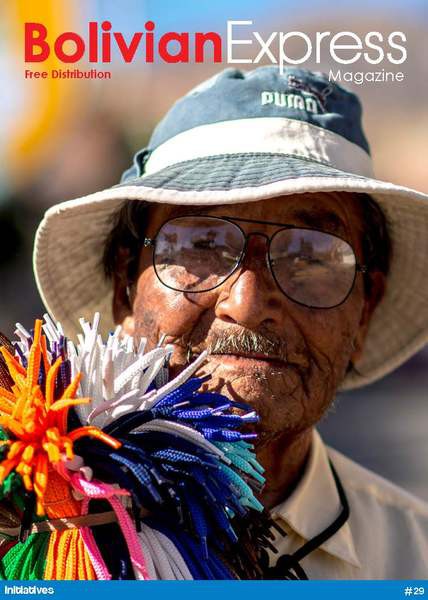
Photo: Amaru Villanueva Rance
'Guatos !' a man shouts from a passing car, as Pedro Machaca slowly stumbles down Avenida Montenegro, with an assortment of colourful shoelaces slung over his shoulder. He turns to greet the man, but he is already gone. Don Pedro, now and elderly man, has been selling laces in San Miguel for the past fifteen years.
A humble profession for a father of six, he says that he earns as little as Bs. 20 on bad days, and upwards of Bs. 40 when things are going well. Don Pedro lives near the General Cemetery and has to travel 15 km on a micro, across opposite ends of La Paz to get to where he sells his laces. ‘It’s far away!’ exclaims Don Pedro, ‘but micro will bring me here, Micro comes!’
We walk down the road towards the roundabout at the bottom of calle Montenegro. He hobbles down slowly, but silently determined. With this same patience, he walks up and down the sloping streets of San Miguel every day. Perhaps most distinctive is his cheerfulness to be engaged by passers by, a trait for which he has become a local celebrity and institution in this neighbourhood. He is known by the names of ‘Don Pedro’, ‘Don Guato’, ‘Don Batons’, or simply ‘Guato’, to the thousands of people who, like him, walk up and down these streets.
Pedro Machaca brings a typical Paceñan charm to an area of the city that has an atypical consumerist feel to it. He is a familiar and welcome sight to many of the locals there. 'He’s a very sweet man, and he always has a smile'; 'this man radiates tenderness', and 'someone who deserves much respect' are a few things that Paceños have said about this personaje . His fame is such that a picture of him taken by Silvia Salinas Mulder (and subsequently posted on the Humanos de La Paz Facebook page) already has over 1,000 likes, not to mention the dozens of comments of appreciation which followed his online appearance.
Photos: Amaru Villanueva Rance
Photo: Michael Newport CC @Flickr
Every Sunday Mariano Roque Ylofayo travels 60 km from the city of Sucre to Tarabuco to sell traditional local clothing at the town’s legendary market. The historical charm and significance of Mercado de Tarabuco has been attracting buyers and sellers alike from across the surrounding communities for several centuries.
What’s perhaps most distinctive about this market is that money is not needed in order to leave with goods. Whilst money can be used, many prefer to bypass using money and simply exchange their products through a bartering process, or trueque. 'I think that it is better when goods are exchanged for goods and money is not involved', Mariano tells me. 'There are times when I find that with money one can be deceived'.
There is a certain sense to this logic: people at the market know what they have and what it would take for them to give it up, so why let money complicate the process? However, once Mariano starts to explain how the exchanges take place I begin to think that perhaps there are no real practical reasons for this bartering system, but rather that it is an attempt to keep alive a cherished tradition for which the market has become well known.
The value of products are first converted into monetary terms, and then converted back into the value of the other products involved. 'This poncho would cost Bs. 20, let’s say 3 kg of carrots is Bs. 6; so my poncho would cost 10 kg of carrots' Mariano explains. So rather than a way to bypass the need for money, monetary value is paradoxically at the core of this type of exchange, being used as a proxy to decide the relative value of each good.
In addition to this, there is limited room for negotiating a yapa or rebaja for products when exchanging them, as the value of the products are predetermined by the leaders of the market in a meeting with the Mayor of Tarabuco. 'All the prices are closely regulated by those in charge', explains Mariano.
The market of Tarabuco was founded next to the mountain Qara Qara on the 29th June 1578 by the governor Don Francisco Toledo. Centuries later, its surrounding countryside was host to three of the most crucial battles during the Wars of Independence. Much of this history is remembered and celebrated during Tarabuco’s many festivals. Along with its history, the town’s architecture and its natural beauty have led to Tarabuco being declared a site of ‘National Heritage of Historic and Cultural Priority in Bolivia’.
'As well as celebrating the anniversary of Tarabuco during the festival of San Pedro on the 29th June, there is also the celebration of the Virgen del Rosario in the month of October,' Mariano explains. 'There are many traditions in Tarabuco. These are times to be spent dancing, drinking and sharing with family.'

 Download
Download





















